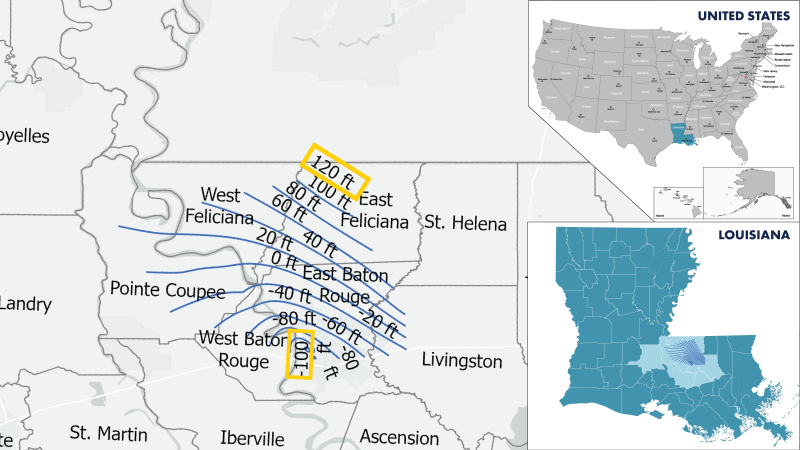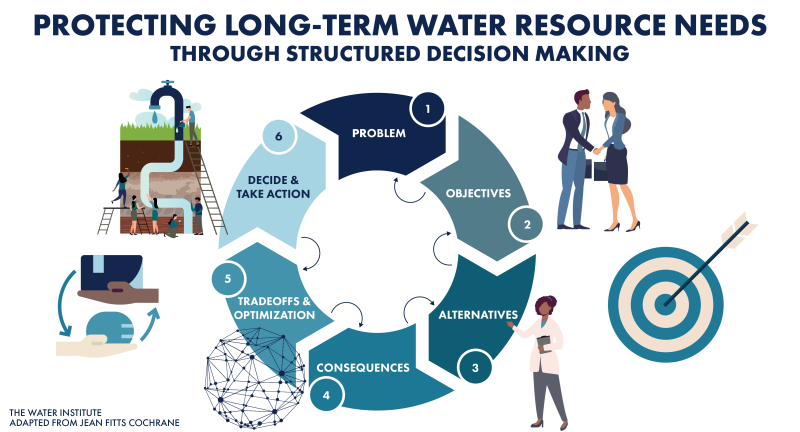The Southern Hills Aquifer System has been providing groundwater for municipal and industrial use in Baton Rouge, the capital of Louisiana, since the 1890’s. The Capital Area Ground Water Conservation Commission (Commission), consisting of 18 members from industry, public, and environmental sectors, was created by the Louisiana Legislature in 1975 to manage and regulate groundwater use due to concerns over water level declines, saltwater encroachment across a fault from a salt dome, and subsidence caused by over-pumping of groundwater.
The Commission has historically invested in monitoring and modelling to inform the setting of its groundwater use priorities and production limits. However, because of the wide variety of viewpoints on groundwater use, it has been challenging for the Commission to reach consensus on actions needed to conserve the aquifer. In its more than 45-year history, the Commission has not conducted long-term strategic planning. Meanwhile, saltwater intrusion has continued to threaten municipal and industrial water supplies. There are questions as to (1) what actions and strategies are needed to effectively conserve the aquifer, (2) what actions also consider the economic viability of the area, and (3) if the state of the science is sufficient to support implementation of various strategies and actions.
The Commission hired an outside 3rd party, The Water Institute, to facilitate its long-term strategic planning. The Water Institute is a non-profit non-advocacy applied research institute focused on science to support decision-making. The Institute brought together the Commission and partners from the federal government, consulting, and academia to apply the PrOACT structured decision making (SDM) framework, which includes: Defining the PRoblem, identifying Objectives, identifying Alternatives, evaluating and forecasting the Consequences, evaluating the Trade-offs, making the decision and taking action (Hammond et al., 1998). This SDM framework facilitated a process that integrated the values of the Commissioners into the science-based objective-setting for the long-term strategic plan. The Institute worked with the Commission and other stakeholders to identify and evaluate feasible and cost-effective, science-based alternatives that identify management actions to meet the capital area’s long-term water needs. A Groundwater Availability Model (GAM) is being developed to evaluate these management alternatives. The GAM results will be used in combination with research into conservation measures, social science, public-private partnerships, economic forecasts, and legal purview to complete a consequence analysis for each management alternative. This analysis will enable the Commission to develop aquifer management policies within their legal purview based on sound science.
Using a facilitated process based on the principles of structured decision making, the 18 members of the Commission successfully navigated a complex decision-context to reach consensus on five fundamental objectives, as well as on the potential actions and alternatives that would support strategic planning to implement their vision. This is a significant milestone since the Commission’s founding in 1975. Key to the success of this effort was bringing in an unbiased 3rd party facilitator of a science-based SDM process to enable the Commission to move forward in the face of conflict.
The Commission’s first ever long-term strategic plan is now being developed through a series of intermediate milestones the Commission intends to achieve on the way toward achieving its long-term objectives. The actions under consideration include regulation and monitoring of groundwater withdrawal, mitigation of the environmental effects of withdrawal, support of relevant scientific studies, as well as working with partner agencies to implement measures to conserve, develop, and supplement groundwater resources.
To access the document that outlines the framework for the strategic plan, and the Phase 1 State of the Science report, visit https://thewaterinstitute.org/projects/long-term-strategic-water-sustainability-plan.
As with many groundwater investigations, data on the aquifer is challenging to find. Pumping data in the Southern Hills Aquifer system, has thus far, only been collected as voluntary reporting from major users. A metering program is soon to begin and will be an important part of understanding sustainable withdrawals from the aquifer.
An abundance of surface water in Baton Rouge (i.e., the Mississippi River) and frequent rain induced flooding, make communicating groundwater supply issues more challenging than other drier places in the USA. A perception of water abundance can result in lower adoption of water conservation measures.
This work has highlighted the importance of having an unbiased 3rd party facilitate the process. Commissioners are appointed every two years by the Governor and they serve a maximum of two terms. Since the start of this process, most of the Commissioners have changed, however the consensus on objectives and path forward on the long-term strategic planning has continued. Trust-building and meeting with Commissioners is time-consuming and time for that engagement needs to be included in the planning process. Building trust between The Water Institute and each individual Commissioner has been key to continue moving this planning process forward.
The Water Institute hopes to continue facilitating the Commission through the next steps in the SDM process, leading to the development of a full 50-year strategic management plan.



